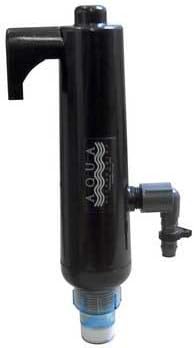Disclaimer: This page contains advertisements and/or affiliate links. We receive compensation from clicks and/or purchases made through these links. Though we may not have tested the specific product(s) mentioned, we do our best to recommend products that are beneficial to our visitors.
UV Sterilizer for Reef Tanks
Last updated on January 30th, 2025

What is UV Filtration for Reef Tanks
A UV Filter, really a UV Sterilizer, uses ultraviolet light to, you guessed it, sterilize anything that passes through it. The UV Sterilizer uses a light-proof tube, and a UV light in the center with a quartz sleeve arount the bulb protecting it from water. When the UV A, B, and C from the light interacts with algae, bacteria, and parasites, it affects the DNA. This can cause sterilization, meaning the thing that passed through cannot reproduce, shorten the lifespan of the micro-organism, or even kill the organism. The affect largely depends on the organism, the time it is in contact with the light, and the intensite of the UV itself.

Why Use a UV Sterilizer in a Reef Tank
UV is used for a few things in saltwater aquariums. The first, and most popular, is that it clarifies the water. Much like activated carbon, UV will help make your aquarium water crystal clear! This happens by starilizing the algae and other organisms in the water column. Causing the organisms to die off without reproducing, leaving your water SPOTLESS!
Please note, UV will NOT help with algae and other organsims that are NOT in the water column. For example, hair algae stays on the rock and will not go through the UV, so it will not be affected. This is true of other organisms such as ich, and cyanobacteria as well.
UV sterilizers are also found to help with reducing things such as ich, dinos, and other parasites and bacterial outbreaks while they are in the free-swimming stages of their lives. Since all of these also have non-free-swimming phases, it is likely that UV will not completely get rid of them. But it does help reduce the populations and keep them from taking over completely.
How Much UV Do I Need for a Reef Tank
Reading some articles, it seems that the recommended flow rate is between 3 and 4 times the tank's total volume per hour. So for a 75 gallon tank with a 25 gallon sump (100 gallons total), you would want 300 to 400 gallons per hour to flow through the UV sterilizer.
That then brings the question of how many watts of UV are needed. For killing/sterilizing algae, 30,000 uW/S/Sq.cm (microwatts/sec/square cm) is needed. For some parasites, 72,000 uW/S/Sq.cm is needed. As much as I would like to provide a simple cheat sheet for flow//wattage requirements, it looks like this depends a lot on which UV Sterilizer you use. Since they have different dimensions, the math is different for all of them. So you'll need to look at the documentation and find the flow rate that matches the goal you have. Personally, I would aim to have a slower flow rate to hit 72,000 - 90,000 uW/S/Sq.cm. That way you know all options are available.
Downsides of UV Sterilizers in Saltwater Aquariums
The first downside is the price. Not only is the UV Sterilizer expensive, but the bulbs are also expensive and so is the power that the UV Sterilizer uses. In addition to cost, UV Sterilizers can cause medications to be ineffective. For example, UV breaks down medication such as Cipro. In theory, the UV can reduce the need for antibiotics, but if you do need to use any, you will want to turn off the UV for that period of time.
Conclusion
UV Sterilizers are a popular filter for saltwater aquariums. While not crucial like other methods of filtration, UV Sterilizers clarify your water and have other benefits as well! From minimizing bacteria to reducing the risk of parasites in fish. But it comes at a litteral cost. So now you have to decide if the benefits outweigh the price.

About the Author
John Krenzer

John is a Software Engineer with a passion for saltwater aquariums, as well as the founder and president of Reef Stable. He started in the aquarium hobby as a child with a 20 gallon freshwater aquarium. His interest in aquarium life grew and in 2008, John set up his first saltwater aquarium.
Today, John maintains an over 300 gallon reef tank system, consisting of a 120g reef and a 210g reef. These large tanks are contained within the same system, sharing a sump as a means to reduce total maintenance and increase total water volume.
John writes articles for the blog as a means to learn about more reef aquarium topics. These articles act as a reference for the readers as well as himself. John updates these articles frequently to provide additional information or make corrections as new information becomes available.
If you would like to request an article, tank tour article, or to collaborate, let me know via the











Social Media